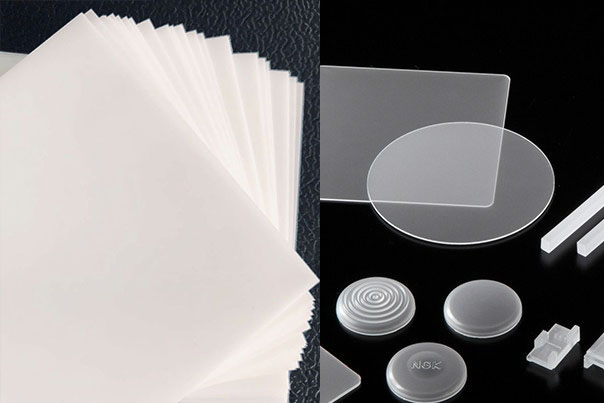Sapphire, Ruby, and Alumina Substrates, How to Choose
No oxide-based substrate in modern materials science has influenced technology more than sapphire, ruby, and alumina. At first glance, they all belong to the same family: aluminium oxide (Al₂O₃). Yet their structures, costs, optical properties, and functional usage position them for extremely different applications.

Why Sapphire Reigns Supreme in LED Manufacturing
Sapphire is the single-crystal form of aluminium oxide. Pure, it is colourless and transparent, with excellent hardness (Mohs 9) and chemical inertness. These make sapphire an ideal substrate for light-emitting diodes (LEDs).
1. Crystal Structure for Epitaxy
The process of making LEDs involves the deposition of gallium nitride (GaN) films through epitaxy. Epitaxy works only if the substrate can accommodate a crystalline form that is comparable to the one being deposited. A single-crystal sapphire lattice acts as this template to create high-purity GaN films with fewer defects.
2. Optical Transparency
LEDs must emit light output efficiently. Sapphire is clear across a wide wavelength range from ultraviolet to infrared, with minimal absorption of photons. This directly contributes to higher brightness and efficiency.
3. High-Temperature Stability
Epitaxial growth occurs at high temperatures greater than 1000°C. Sapphire's stability and form are maintained when such temperatures are reached, making it valuable in LED manufacturing.
Aside from LEDs, sapphire substrates are also employed for laser windows, optical components, and covers protecting consumer electronics. Their relatively high price, however, limits their application in areas where cheaper substitutes could work.
Why Alumina Ceramics Are The Preferred Choice for Electronic Circuits
Whereas sapphire is single-crystal, alumina substrates are polycrystalline ceramics. Created through sintering Al₂O₃ powders, alumina substrates lack the ordered lattice that sapphire possesses but compensate for it with lower cost, excellent mechanical strength, and well-developed production processes.
1. Low Cost for Large-Scale Production
Alumina substrates cost significantly less to manufacture than single-crystal sapphire. This renders them practical for large-area applications such as electronic circuit boards.
2. Electrical Insulation
Among the advantages of alumina is its capability as an electrical insulator. This is a requirement in circuit substrates as they must keep electrical paths separated to prevent short circuits and interference.
3. Thermal Conductivity
Modern electronic devices, especially power modules, generate considerable heat. Alumina substrates dissipate heat effectively from active devices, minimising the possibility of overheating. Although materials like aluminium nitride (AlN) exhibit superior thermal conductivity, alumina provides the best compromise between performance and cost-effectiveness.
4. Mature Processing
Alumina ceramics are easy to cut, drill, and print with conductive layers, enabling mass production of thick-film circuits, microwave devices, and power electronics.
For these reasons, alumina has emerged as the preferred substrate for electronic circuits, power modules, and heat spreaders in industries from consumer electronics to automotive systems.
Why Ruby Remains A Fundamental Component of Solid-State Laser Technology
Ruby is essentially sapphire with a difference: it is a single-crystal form of Al₂O₃ doped with trace amounts of chromium ions (Cr³⁺). The ions not only confer ruby its red colour but also render it optically active in a distinct way.
1. Optical Activity Due to Chromium Doping
The Cr³⁺ ions in ruby absorb energy and emit it as light at a specific wavelength. When undergoing optical pumping, this produces an intense and coherent red laser beam of wavelength 694 nm.
2. Strong Mechanical and Chemical Properties
Ruby shares the mechanical hardness and chemical stability of sapphire, ensuring its ability to endure the harsh environments required for laser operation.
3. Specialized Application
The optical properties of ruby render it useful in solid-state lasers, which were the first successful lasers. However, the same chromium doping that benefits ruby in lasers limits its usefulness in LEDs, which require transparency, and in electronic circuits, where cost and ease of manufacture in large quantities are paramount over optical activity.
Thus, the role of ruby is highly specialized: it excels in laser technology, optical sensing, and precision instruments, but is not applicable in semiconductor manufacturing or mass-market electronics.
How to Choose
Sapphire dominates LED technology, where crystal structure and transparency are critical. Alumina prevails in electronic circuits and power modules, where insulation and cost are significant. Ruby, whose optical activity is stimulated by chromium, is particularly suited to lasers and scientific optical devices.
The choice largely depends on whether your project prioritises clarity, insulation, or laser performance. For more alumina substrates, please check Stanford Advanced Materials (SAM). If you are still uncertain, please send us your project details and we will assist in recommending the appropriate solution.

 Bars
Bars
 Beads & Spheres
Beads & Spheres
 Bolts & Nuts
Bolts & Nuts
 Crucibles
Crucibles
 Discs
Discs
 Fibers & Fabrics
Fibers & Fabrics
 Films
Films
 Flake
Flake
 Foams
Foams
 Foil
Foil
 Granules
Granules
 Honeycombs
Honeycombs
 Ink
Ink
 Laminate
Laminate
 Lumps
Lumps
 Meshes
Meshes
 Metallised Film
Metallised Film
 Plate
Plate
 Powders
Powders
 Rod
Rod
 Sheets
Sheets
 Single Crystals
Single Crystals
 Sputtering Target
Sputtering Target
 Tubes
Tubes
 Washer
Washer
 Wires
Wires
 Converters & Calculators
Converters & Calculators
 Write for Us
Write for Us
 Chin Trento
Chin Trento



